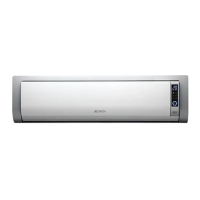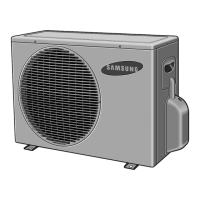What does STD LED blinking mean on Samsung AS07A5MA?
- AAnthony HoldenAug 14, 2025
STD LED blinking (1Hz) means that the Air Conditioner restores from power failure (input initial power).
What does STD LED blinking mean on Samsung AS07A5MA?
STD LED blinking (1Hz) means that the Air Conditioner restores from power failure (input initial power).
What does TIMER LED blinking mean on Samsung Air Conditioner?
TIMER LED blinking (1Hz) means that the Indoor unit Room sensor has an Error (open or short).
What does STD and TIMER LED blinking mean on Samsung Air Conditioner?
STD and TIMER LED blinking (1Hz) means that the Indoor unit heat exchanger temperature sensor has an Error (open or short).
What to do if my Samsung AS07A5MA does not operate but the timer LED is on?
If your Samsung Air Conditioner doesn't operate while the timer LED is lit, the timer is likely activated, placing the unit in ready mode. To resolve this, cancel the timer operation, and the unit should operate normally.
Why my Samsung AS07A5MA Air Conditioner may not operate properly?
Your Samsung Air Conditioner might not be operating correctly if the input voltage isn't within the appropriate range. Ensure the input voltage is within ±10% of the voltage rating.
Why does the compressor stop and fan speed decrease on my Samsung Air Conditioner?
The compressor in your Samsung Air Conditioner might stop intermittently, and the indoor fan speed may decrease in Cool or Dry mode to prevent the air from freezing, depending on the inside and outside air temperatures.
Why does my Samsung Air Conditioner compressor stop in Dry mode?
In Dry mode, the compressor of your Samsung Air Conditioner is automatically controlled based on the room temperature and humidity, which may cause it to stop intermittently.
What does NATURE LED blinking mean on Samsung Air Conditioner?
NATURE LED blinking (1Hz) means that the Indoor fan is malfunctioning (for speed is below 450rpm).
What does All LED blinking mean on Samsung Air Conditioner?
All LED blinking (1Hz) means that there is an Option Error.
User should not install. Ask dealer or authorized company. Improper installation may cause risks.
Damaged power cord must be replaced. Use independent circuit or auxiliary breaker.
Steps for disassembling the indoor unit, including front panel, electrical parts, drain, heat exchanger, fan.
Steps for disassembling the outdoor unit (US07A5(6)MA/US09A5(6)MAF and US12AA(B)MCF), covering common work, fan motor, heat exchanger, compressor.
Procedure to set option codes via remote control after PCB replacement for proper unit function.
Lists specific option codes for different model numbers of air conditioners.
Basic checks for voltage, cable linkage, and common operational issues without specific symptoms.
Detailed troubleshooting flowcharts for various problems like no power, fan not operating, and unit not cooling.
Exploded view diagram showing parts of the indoor unit with corresponding numbers.
Detailed list of parts for the indoor unit, including code numbers, descriptions, and quantities.
Exploded view diagram showing parts of the outdoor unit for specific models.
Detailed list of parts for the outdoor unit, including code numbers, specifications, and quantities.
Diagram and parts list for the internal control assembly of the indoor unit.
Diagram and parts list for the external control assembly of the outdoor unit.
Performance data graphs for total power consumption and total capacity for a specific model.
Graph showing condensing pressure vs. outdoor ambient temperature for different indoor temperatures.
Graph showing suction pressure vs. outdoor ambient temperature for different indoor temperatures.
Graph showing suction temperature vs. outdoor ambient temperature for different indoor temperatures.
Graph showing discharge temperature vs. outdoor ambient temperature for different indoor temperatures.
Performance data graphs for total power consumption and total capacity for a specific model.
Performance data graphs for total power consumption and total capacity for a specific model.
Wiring diagram for the indoor unit, showing connections between components and terminal blocks.
Wiring diagram for the outdoor unit, illustrating connections for power, compressor, fan, and terminal block.
Detailed schematic diagram of the indoor unit's electronic circuitry and components.
Detailed schematic diagram of the outdoor unit's electronic circuitry and components.
| Brand | Samsung |
|---|---|
| Model | AS07A5MA |
| Category | Air Conditioner |
| Language | English |











